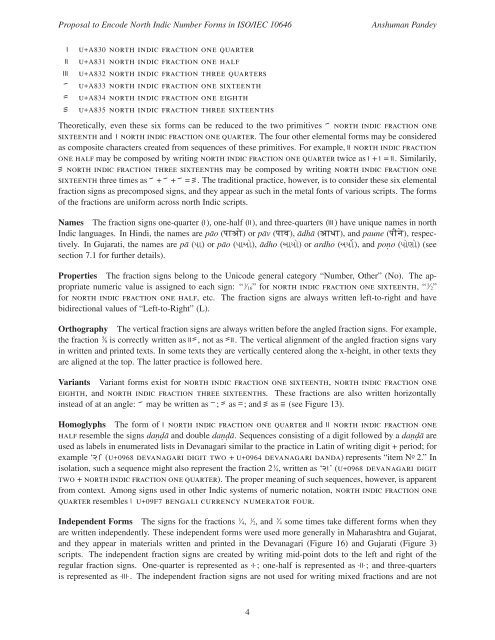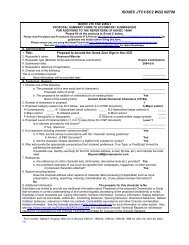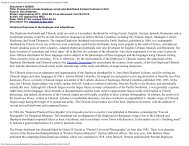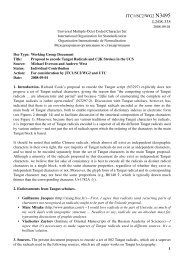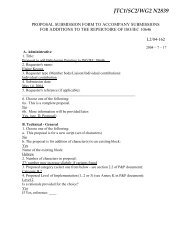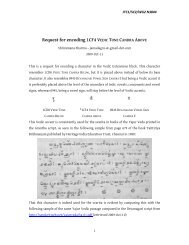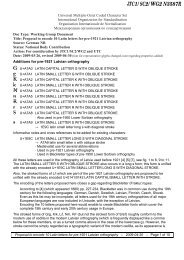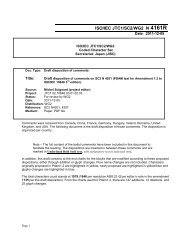Common Indic Number Forms - dkuug
Common Indic Number Forms - dkuug
Common Indic Number Forms - dkuug
You also want an ePaper? Increase the reach of your titles
YUMPU automatically turns print PDFs into web optimized ePapers that Google loves.
Proposal to Encode North <strong>Indic</strong> <strong>Number</strong> <strong>Forms</strong> in ISO/IEC 10646 Anshuman Pandey<br />
ã u+A830 north indic fraction one quarter<br />
ä u+A831 north indic fraction one half<br />
å u+A832 north indic fraction three quarters<br />
à u+A833 north indic fraction one sixteenth<br />
á u+A834 north indic fraction one eighth<br />
â u+A835 north indic fraction three sixteenths<br />
Theoretically, even these six forms can be reduced to the two primitives à north indic fraction one<br />
sixteenth and ã north indic fraction one quarter. The four other elemental forms may be considered<br />
as composite characters created from sequences of these primitives. For example, ä north indic fraction<br />
one half may be composed by writing north indic fraction one quarter twice asã+ã=ä. Similarily,<br />
â north indic fraction three sixteenths may be composed by writing north indic fraction one<br />
sixteenth three times asà+à+à=â. The traditional practice, however, is to consider these six elemental<br />
fraction signs as precomposed signs, and they appear as such in the metal fonts of various scripts. The forms<br />
of the fractions are uniform across north <strong>Indic</strong> scripts.<br />
Names The fraction signs one-quarter (ã), one-half (ä), and three-quarters (å) have unique names in north<br />
<strong>Indic</strong> languages. In Hindi, the names are pāo (a) or pāv (), ādhā (a), and paune (), respectively.<br />
In Gujarati, the names are pā (nÉ) or pāo (nÉçm), ādho (çÉÊm) or ardho (çÊmá), and pon. o (nmÐm) (see<br />
section 7.1 for further details).<br />
Properties The fraction signs belong to the Unicode general category “<strong>Number</strong>, Other” (No). The appropriate<br />
numeric value is assigned to each sign: “ 1 ⁄16” for north indic fraction one sixteenth, “ 1 ⁄2”<br />
for north indic fraction one half, etc. The fraction signs are always written left-to-right and have<br />
bidirectional values of “Left-to-Right” (L).<br />
Orthography The vertical fraction signs are always written before the angled fraction signs. For example,<br />
the fraction 5 ⁄8 is correctly written as äá, not as áä. The vertical alignment of the angled fraction signs vary<br />
in written and printed texts. In some texts they are vertically centered along the x-height, in other texts they<br />
are aligned at the top. The latter practice is followed here.<br />
Variants Variant forms exist for north indic fraction one sixteenth, north indic fraction one<br />
eighth, and north indic fraction three sixteenths. These fractions are also written horizontally<br />
instead of at an angle: à may be written as ü;áasý; and â as þ (see Figure 13).<br />
Homoglyphs The form of ã north indic fraction one quarter and ä north indic fraction one<br />
half resemble the signs dan. d. ā and double dan. d. ā. Sequences consisting of a digit followed by a dan. d. ā are<br />
used as labels in enumerated lists in Devanagari similar to the practice in Latin of writing digit + period; for<br />
example ‘2।’ (u+0968 devanagari digit two + u+0964 devanagari danda) represents “item N ō 2.” In<br />
isolation, such a sequence might also represent the fraction 2 1 ⁄4, written as ‘2ã’ (u+0968 devanagari digit<br />
two + north indic fraction one quarter). The proper meaning of such sequences, however, is apparent<br />
from context. Among signs used in other <strong>Indic</strong> systems of numeric notation, north indic fraction one<br />
quarter resemblesu+09F7 bengali currency numerator four.<br />
Independent <strong>Forms</strong> The signs for the fractions 1 ⁄4, 1 ⁄2, and 3 ⁄4 some times take different forms when they<br />
are written independently. These independent forms were used more generally in Maharashtra and Gujarat,<br />
and they appear in materials written and printed in the Devanagari (Figure 16) and Gujarati (Figure 3)<br />
scripts. The independent fraction signs are created by writing mid-point dots to the left and right of the<br />
regular fraction signs. One-quarter is represented as ø; one-half is represented as ù; and three-quarters<br />
is represented as ú. The independent fraction signs are not used for writing mixed fractions and are not<br />
4


